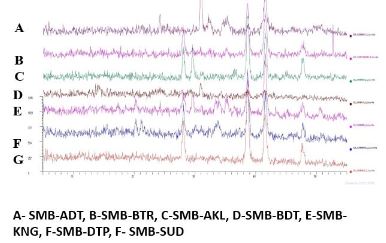Comparative Study of Marketed Samples of Svarnamakshika Bhasma an Ayurvedic Medicinal preparation, using XRF and XRD Analysis
DOI:
https://doi.org/10.21760/jaims.9.11.15Keywords:
Svarnamakshika, Bhasma, Chalcopyrite, X-Ray Fluorescence, X-Ray diffractionAbstract
Svarnamakshika Bhasma is an Ayurvedic medicinal preparation widely used by Ayurvedic practitioners for the management of various ailments. Svarnamakshika Bhasma needs to be prepared from Svarnamakshika, a mineral product identified and defined as Chalcopyrite (CuFeS2) in Ayurvedic Pharmacopeia of India (API). Minimum quantities of Iron, Copper and Sulfur, the three major elements necessary to be present in the Svarnamakshika (chalcopyrite), are prescribed as Pharmacopeial quality standard in the API monograph. Since included in the API, it is mandatory for the manufacturer to use Svarnamakshika (chalcopyrite) as specified in the API for preparation of Svarnamakshika Bhasma. However, it is generally observed that Svarnamakshika (chalcopyrite) complying with the standards prescribed by API is rarely found used for preparation of Svarnamakshika Bhasma. On this background seven samples of Svarnamakshika Bhasma comprising five marketed and two prepared by research scholars along with two samples of raw Svarnamakshika collected from research scholars were analysed in this study by using XRF and XRD analysis. The study indicates that only one marketed sample appears to have been prepared using Svarnamakshika (chalcopyrite) of pharmacopeial standard prescribed by API.
Downloads
References
Anonymous. Ayurvedic Pharmacopeia of India, Part I, Vol VII, First Edition. Govt. of India, Ministry of AYUSH, New Delhi; 2008. p. 36.
Anonymous. Ayurvedic Pharmacopeia of India, Part I, Vol VII, First Edition. Govt. of India, Ministry of AYUSH, New Delhi; 2008. p. 38.
Haldar SK. Platinum-Nickel-Chromium Deposits, Geology, Exploration, and Reserve Base. 2017: 1-35. Available at: https://doi.org/10.1016/B978-0-12-802041-8.00001-8
Wen S, Liu J, Deng J. Component release of fluid inclusions in sulfide mineral. In: Fluid Inclusion Effect in Flotation of Sulfide Minerals. 2021. Available at: https://doi.org/10.1016/B978-0-12-819845-2.00005-3
Zhao H, Yang C, Zhang X, Zhang Y, Qiu G. Dissolution and passivation mechanism of chalcopyrite in bioleaching. In: Biohydrometallurgy of Chalcopyrite. 2021: 125-156. Available at: https://doi.org/10.1016/B978-0-12-821880-8.00006-3
Anonymous. Drugs and Cosmetics Rules 1945. Govt. of India, Ministry of Health & Family Welfare, Dept of Health, as amended up to 31st December 2016.
Bhardwaj R, Johar S, Kapila A, Sharma A. Physicochemical Study and Quantitative Analysis of Swarnamakshika Bhasma. Int J Pharm Biol Sci Archive (IJPBA). 2021;9(1):7-15. DOI: https://doi.org/10.32553/ijpba.v9i1.172
Mohapatra S, Jha CB. Analytical study of raw Swarna Makshika (Chalcopyrite) and its Bhasma through TEM and EDAX. AYU. 2013;34(2):204-208. DOI: 10.4103/0974-8520.119682
Nambiar S, Kadibagil VR, Hussain G. Physicochemical Analysis of Swarnamakshika Bhasma Prepared by Two Different Methods. Annals of Ayurvedic Medicine. 2019;8(3-4):94-103.
Nair RR, Lakshmi ST. Preparation and Physicochemical Characterisation of Swarna Makshika Bhasma. Int J Ayurveda Pharma Res. 2018;6(11):48-54.















